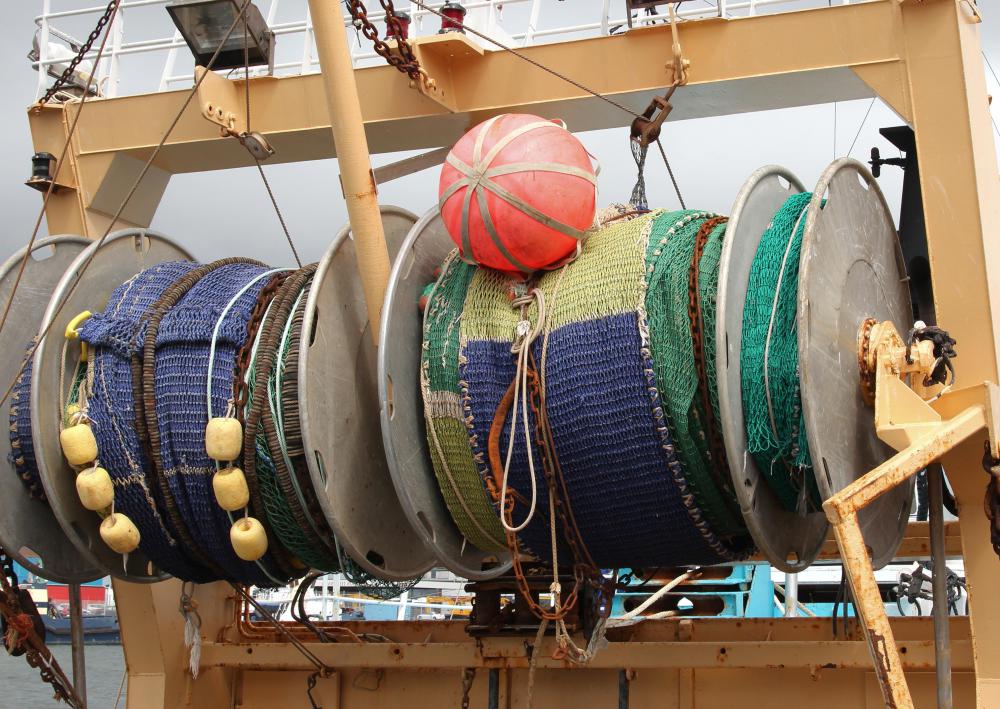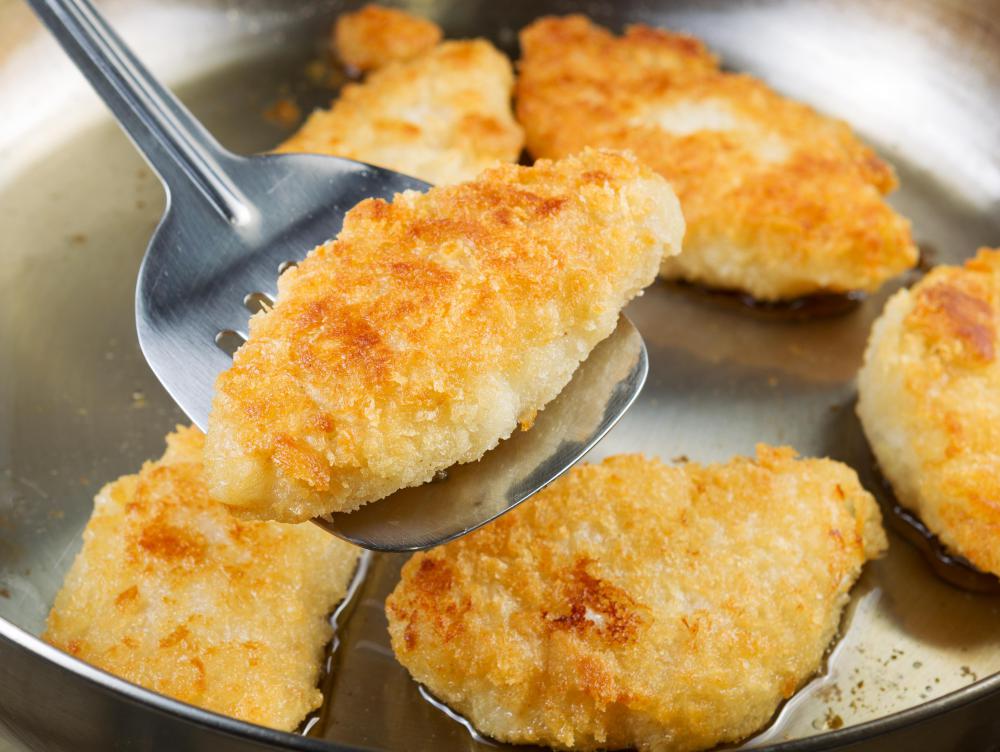At AllThingsNature, we're committed to delivering accurate, trustworthy information. Our expert-authored content is rigorously fact-checked and sourced from credible authorities. Discover how we uphold the highest standards in providing you with reliable knowledge.
What is a Whitefish?
A whitefish is a broad term that refers to a category of fish that generally live near the bottom of water sources, such a lakes, oceans, ponds, and aquariums. They are equipped to comfortably reside in close proximity to loose sand and debris. Due to being located near the bottom of water sources near sand, members of this fish category generally have a dry and flaky texture to their flesh when they are cooked and consumed, especially compared to fish who reside closer to the surface of the water and tend to have an oilier texture. Some common types of whitefish are cod, pollock, and halibut.
Since whitefish remain as close to the bottom of a water source as possible, they are commonly referred to as bottom feeders. Bottom feeders are typically exposed to sand, pebbles, and other loose debris. In order to comfortably adapt to this environment, bottom feeder fish use a process to filter out any debris they inhale. As these fish inhale the water and any debris, their internal breathing mechanism — known as a gill — filters out all non-water materials out of the body through a slit.

Whitefish generally live in a wide variety of water sources, such as rivers, lakes, and oceans. They also reside in various geographical locations throughout the world, including North America, Europe, and Asia. Their diets can vary depending on the specific type of fish, but can range from insect larvae to other small fish.
When whitefish is caught by fisherman and packaged and sold for food, its proximity to the bottom of the water source provides its distinctive texture once it is cooked. The fish has a drier texture, which adds firmness and allows the fish to maintain its shape while it cooks. Fish that live closer to the surface of water sources have an oil content that can make it too delicate to withstand high temperatures during cooking. The firm texture of whitefish makes it able to hold up during many cooking methods, especially deep frying in hot oil.

This variety of fish is most commonly used in the traditional British recipe of fried fish and chips, as well as commercial fish sticks, because it is firm enough to keep its shape and allow a batter or coating to stick to it. It can also be processed into a gel and formed into sticks to be sold as imitation crabmeat. The fish is also a common ingredient in traditional Jewish cuisine, especially served with bagels.
Frequently Asked Questions
What exactly is a whitefish?

A whitefish refers to several species of fish that are typically found in cold, northern waters, such as those in Canada and the northern United States. They are part of the family Salmonidae, which also includes salmon and trout. Whitefish are known for their mild flavor and are popular for commercial fishing and sport fishing.
Are there different types of whitefish?
Yes, there are several species commonly referred to as whitefish. The most well-known include the lake whitefish and the mountain whitefish. Each species has unique characteristics, but they generally share traits like a silvery body and preference for cold, freshwater habitats. They are also predominantly bottom feeders, consuming aquatic invertebrates.
What is the habitat of a whitefish?
Whitefish are typically found in cold, freshwater environments such as lakes, rivers, and streams. They thrive in northern regions like the Great Lakes in North America and are well-adapted to life in deep, cold waters where they often inhabit sandy or rocky bottoms. Their distribution is closely tied to water temperature and quality.
How important are whitefish to ecosystems and economies?
Whitefish play a crucial role in their ecosystems as both predators and prey, helping to maintain balance. Economically, they are significant to commercial fisheries, especially in the Great Lakes region. According to the Great Lakes Fishery Commission, the Great Lakes commercial fishery is valued at over $7 billion annually, with whitefish being a key species.
What do whitefish eat?
Whitefish are generally bottom feeders, with a diet consisting mainly of small invertebrates such as insect larvae, snails, and crustaceans. Their feeding habits help control the populations of these organisms, contributing to the health of their aquatic ecosystems. Occasionally, they may also feed on small fish or fish eggs.
How can one identify a whitefish?
Whitefish can be identified by their silvery coloration, small head, and forked tail. They have a delicate, small-scaled body and a mouth that points downward, reflecting their bottom-feeding nature. During spawning, some species may develop a darker coloration. Anglers often recognize them by their size, which can range from 1 to 5 pounds on average.
AS FEATURED ON:
AS FEATURED ON:













Discussion Comments
I started eating imitation crab meat a few years ago, and I found out from a friend that it is made of surimi, that gel made from processed whitefish. I had been wondering what was used to make it, and I was happy to find out that it still contained some type of seafood.
Imitation crabmeat is kind of rubbery. You can tear off pieces of it, yet it holds together well and doesn't fall apart. It tastes a lot like the real thing, but it stays fresh longer.
I like to put pieces of imitation crabmeat on top of cucumber slices and eat them with a cracker. It is also good in a salad of lettuce, cucumber, and Italian dressing.
I have always loved fish sticks, though the package is kind of mysterious about the ingredients. It only states that they are made from whitefish, and until now, I didn't know what one was.
I am impressed with how well fish sticks hold together. Even when you cut into them with a fork, they maintain their shape. I didn't know that this was just a whitefish characteristic.
Whenever I eat fish sticks, I like to eat breaded shrimp along with them. The extra fishy flavor of the whitefish goes well with the strong seafood taste of the shrimp, and since both are breaded, the textures go well together, too.
@Oceana – I believe catfish is a whitefish. They feed along the bottom of ponds and lakes, and as you said, they hold up well in hot oil.
I never knew before reading this article that whitefish breathed in and filtered out sand. I have seen catfish in a clear lake before, and I know that a lot of sand gets stirred up from people swimming around them, so it is good that they have that ability.
It's kind of hard to eat whitefish when you think about them eating junk off the bottom of ponds. I try not to think about it, though, because whitefish can be delicious!
Does anyone know if catfish is considered a whitefish? Here in the South, there are numerous restaurants that serve fried catfish, and I eat it all the time. However, when my family from up North came to visit, they were surprised to find that we eat what they consider “bottom feeders.”
The fish is almost always deep fried, and it has an extremely flaky texture. It always seems to take on the flavor of the water it was raised in, so most of it has a slight pond water taste. The seasonings and oil keep this from being overpowering or offensive, that is, if it is cooked correctly.
When I convinced my family to try catfish, they were pleasantly surprised. My sister-in-law said that she wanted to tell everyone in New York that catfish is wonderful!
Post your comments